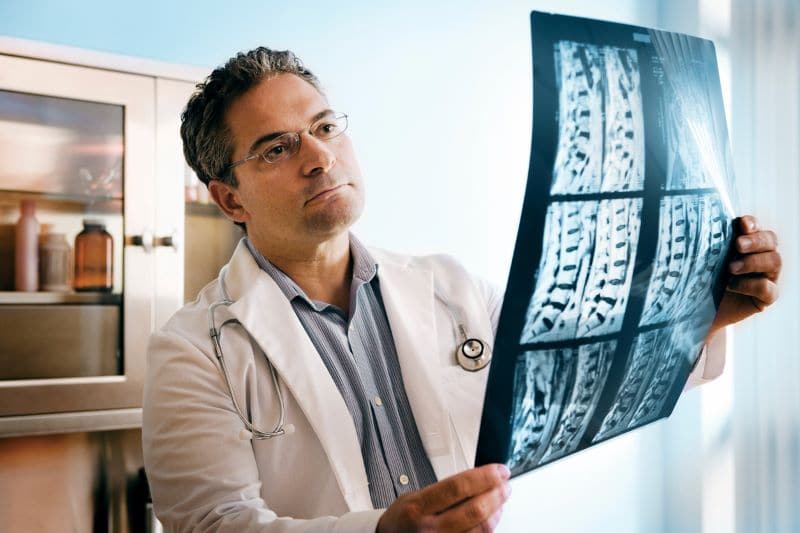Disk Herniation Injuries
A herniated disk or slipped disk occurs when a spinal disk is forced through a weak point and protrudes from its natural place. This may place pressure on nearby nerves and cause pain. The lower back or lumbar area of the spine is the most common area for a slipped disk. The neck that contains cervical disks is a less common area for a slipped disk. The upper-to-mid-back thoracic disks are rarely involved.
If you have been involved in an accident that caused a herniated disk or slipped disk, our Utah spinal cord injury lawyer can help you file a claim to recover compensation from the injury you sustained.

Table of Contents
Symptoms of Disk Herniation
The symptoms that are indicative of herniated disk include low back or neck pain that tingles mildly. You could feel a dull ache, burning, or pulsating pain. Numbness and the inability to move may occur. Usually, the pain occurs on one side of the body.
- Lower back. If the lower back is affected, there is usually sharp pain in one part of the leg, hip, or buttocks. Then, there is numbness in other parts of the body. The affected leg shows weakness, and there may be pain or numbness on the back of the calf or sole of the foot.
- Neck. If the slipped disk is in the neck, it will be painful to move the neck. Plus, there will be a deep pain near the shoulder blade. The pain usually moves to the upper arm but rarely to the fingers. Numbness is present along the shoulder and down the arm. The pain may worsen after standing or sitting and during the night. Sneezing, coughing, and laughing can aggravate the pain.
Pain from a slipped disk in the neck becomes worse when bending backward or walking for some distance. A medical examination may be needed to explore symptoms. It is best to consult a doctor as soon as possible. The pain, numbness, or weakness may improve over a period of weeks to months.
Causes of Slipped Disks
According to Medline Plus, slipped disks occur more often in middle-aged and older men, usually after strenuous activity. Risk factors include conditions present at birth that affect the size of the lumbar spinal canal. Disk herniation is often gradual, resulting from age-related wear and tear.
As you age, your spinal disks lose some of their water content. This makes them less flexible and more prone to tearing or rupturing.
Falls and sudden trauma rarely cause a herniated disk. However, the disks may move out of place from injury or strain. The result may be pressure on the spinal nerves that can cause pain, numbness, or weakness.
Diagnostic Test for Herniated Disk
Diagnostic testing for a herniated disk may include:
- An electromyogram (EMG) may be done to determine the exact nerve root involved.
- A myelogram may be done to determine the size and location of disk herniation.
- Nerve conduction velocity tests.
- Spine MRI or spine CT showing if the herniated disk is pressing on the spinal canal.
- An X-ray may be done to rule out other causes of back or neck pain. However, it is not possible to diagnose a herniated disk by a spine x-ray alone.
Treatment for a Slipped Disk
Treatment for a slipped disk may include medication and therapy. It may take several months to see improvement. Medication for slipped disks may include:
- Over-the-counter medication can relieve pain. A doctor can tell you what’s suitable. Over-the-counter drugs carry a risk of gastrointestinal bleeding. Large doses of acetaminophen may damage the liver.
- Narcotics may be prescribed by the doctor if the pain does not improve with over-the-counter medication. Follow your doctor’s advice closely.
- Nerve pain medications such as gabapentin (Neurontin), pregabalin (Lyrica), duloxetine (Cymbalta), tramadol (Ultram, Ryzolt), and amitriptyline may relieve nerve-damage pain. Talk to your doctor about the best options.
- Muscle relaxers such as diazepam (Valium) or cyclobenzaprine (Flexeril, Amrix) can help with back or limb spasms. Sedation and dizziness are common side effects to be aware of.
- Cortisone injections are inflammation-suppressing corticosteroids that may be given by injection directly into the area around the spinal nerves, using spinal imaging to more safely guide the needle.
Accident victims also benefit from physical therapy as a treatment for spinal cord injuries. Physical therapists can show you exercises designed to minimize the pain of a herniated disk. As the pain improves, physical therapy can advance to a core strength and stability program to help protect against future injury. A physical therapist may also recommend:
- Heat or ice
- Traction
- Ultrasound
- Electrical stimulation
- Short-term bracing for the neck or lower back